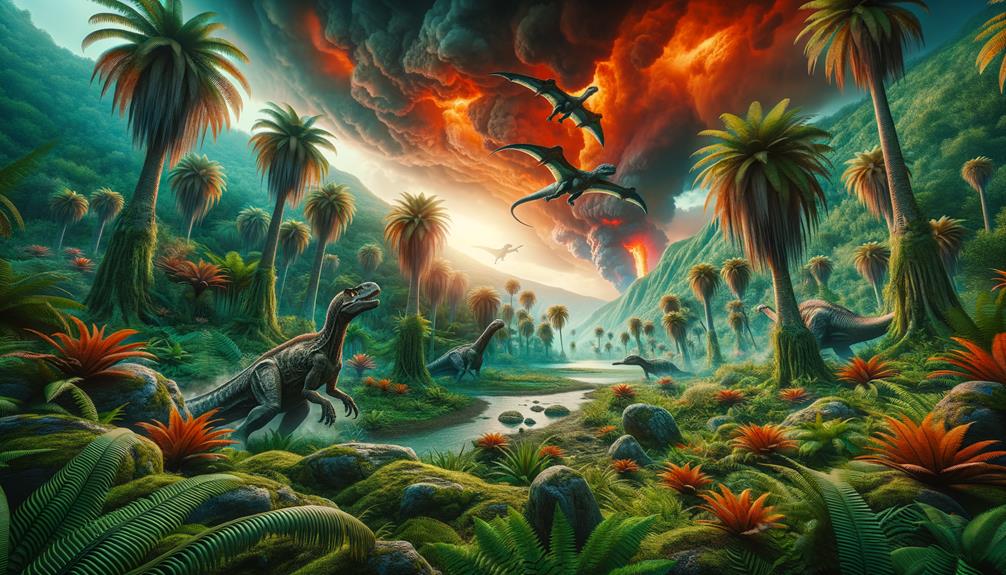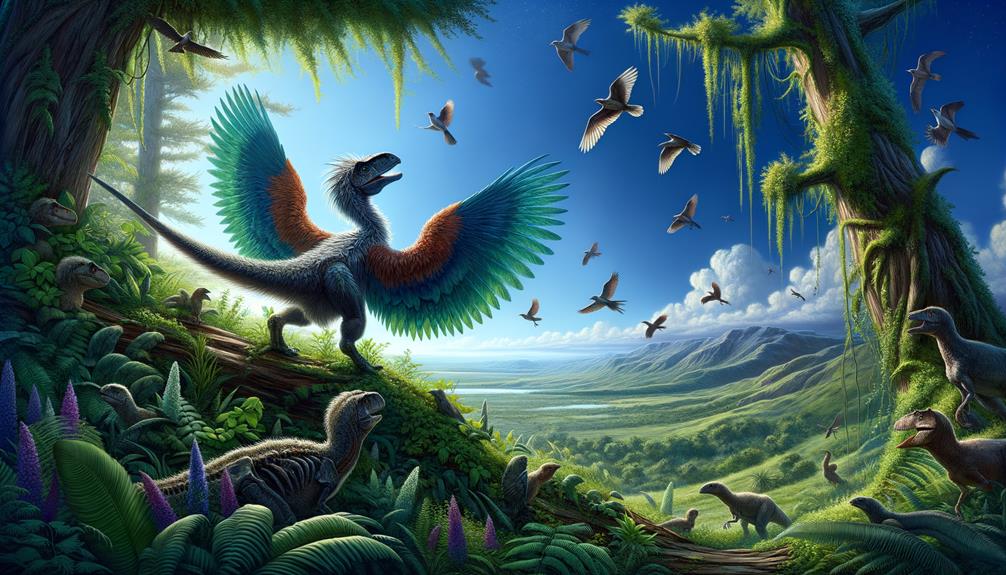I trace the evolutionary split between reptiles and mammals back to around 320 to 315 million years ago, when synapsids and diapsids diverged from a common amniote ancestor. Synapsids, characterized by a single temporal opening, eventually gave rise to mammalian lineages, while diapsids, with two temporal openings, diversified into reptiles and birds. One subgroup of synapsids, therapsids, made significant anatomical advancements, including developing a secondary palate and sophisticated jaw mechanics. Over time, cynodonts evolved into early mammals, exhibiting distinct traits such as heterodont dentition and dentary-squamosal jaw articulation. The rapid diversification of mammals following the Cretaceous period highlights this fascinating evolutionary split.
Key Takeaways
Around 320-315 million years ago, a common amniote ancestor gave rise to two distinct groups: synapsids and diapsids. Synapsids would eventually evolve into mammals, while diapsids diversified into reptiles and birds.
Therapsids, a subgroup of synapsids, developed advanced jaw mechanics and specialized teeth. These traits would become characteristic of mammals.
The mass extinction event that marked the end of the Cretaceous period and the beginning of the Paleogene period led to rapid diversification of placental and marsupial mammals.
Cynodonts, precursors to mammals, exhibited heterodont dentition and advanced jaw articulation, features that would eventually define the mammalian lineage.
Synapsids and Diapsids Divergence
Around 320-315 million years ago, a pivotal moment in vertebrate evolutionary history unfolded as synapsids and diapsids diverged from a common amniote ancestor. This split paved the way for the emergence of mammals on one hand and reptiles and birds on the other. Synapsids, characterized by their single temporal opening in the skull, evolved into the lineage that ultimately led to mammals. Diapsids, with their two temporal openings, diversified into today's reptiles and birds.
During the Permian period, synapsids dominated terrestrial ecosystems, occupying a wide range of ecological niches as both predators and herbivores. However, the Triassic period saw a significant shift as archosaurs, a group of diapsids, began to challenge synapsid dominance. Despite this competition, synapsids continued to adapt, eventually giving rise to mammaliaforms.
The Cretaceous-Paleogene extinction event marked another critical juncture. It led to the rapid diversification and proliferation of placental and marsupial mammals, laying the groundwork for the modern mammalian clade. This evolutionary divergence between synapsids and diapsids has profoundly shaped the vertebrate lineage and the biodiversity we see today.
Evolution of Therapsids
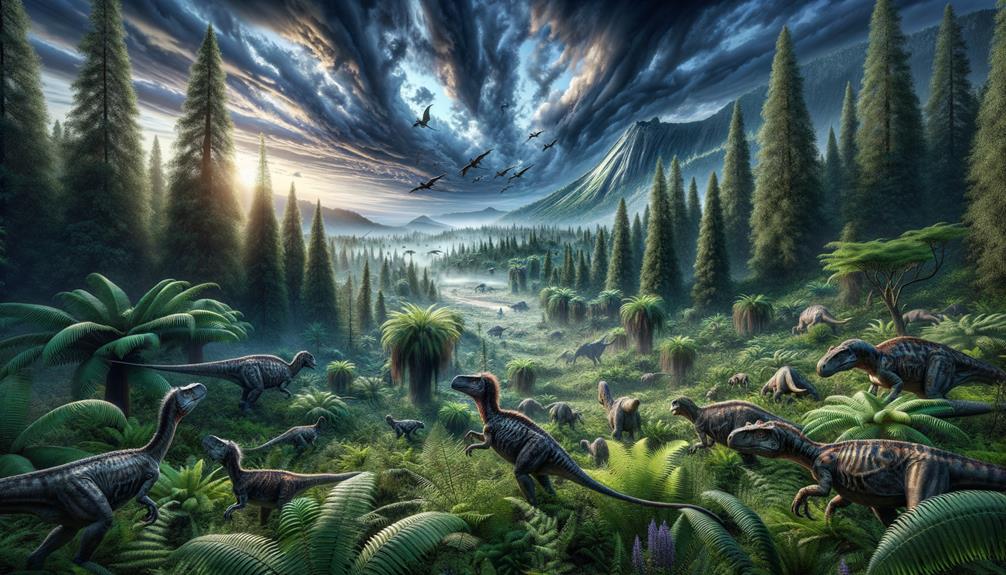
When I look at the evolution of therapsids, I'm struck by their remarkable anatomical changes, such as the development of a secondary palate and advanced jaw mechanics. These adaptations not only improved their feeding efficiency but also allowed them to occupy a wide range of ecological niches, from plant-eaters to meat-eaters. Fossil discoveries offer a rich historical context, revealing the extent of their adaptation and survival, particularly during the dramatic shift from the Permian to Triassic periods.
Therapsid Anatomical Changes
Therapsids underwent significant anatomical changes, particularly in their jaw structure and limb placement, marking a pivotal shift in their evolution from reptile-like ancestors to more mammal-like characteristics. One notable adaptation was the transformation of their jaw bones, which allowed them to breathe while chewing – a trait absent in their reptilian predecessors. This development was made possible by the formation of a secondary palate.
Their teeth became more specialized, with distinct incisors, canines, and molars, highlighting their advanced feeding mechanisms. The jaw joint evolved from a primitive structure to a more sophisticated dentary-squamosal joint, a hallmark of early cynodonts. This transformation was crucial, as it laid the foundation for the eventual development of mammalian middle ear bones, enhancing their auditory capabilities.
The enlargement of the temporal fenestrae allowed for stronger jaw muscles, giving therapsids a more powerful bite. Additionally, the repositioning of limbs under their body improved their mobility and endurance, enabling more active lifestyles. These anatomical innovations collectively facilitated a significant evolutionary advancement, bridging the gap between their reptilian ancestors and the emergence of true mammals. Through these transformations, therapsids exemplified a remarkable evolutionary shift, showcasing nature's ingenuity in action.
Therapsid Ecological Niches
During the Permian period, therapsids occupied a wide range of ecological niches, showcasing their adaptability and resulting in diverse specialized forms. Among these, herbivorous dicynodonts thrived, developing tusks and robust skulls to effectively process tough plant material. In contrast, the formidable gorgonopsians, a group of carnivorous therapsids, developed powerful jaws and sharp teeth, solidifying their role as apex predators.
As the Triassic period began, the rise of archosaurs challenged these dominant therapsids. The larger forms faced extinction, giving way to more adaptable, smaller therapsids. Among these, the cynodonts emerged, displaying significant evolutionary advancements. They developed a secondary palate, allowing them to breathe while chewing, and improved jaw mechanics that facilitated more efficient feeding strategies. These adaptations enabled cynodonts to exploit a variety of feeding niches, from insectivory to omnivory.
The evolutionary trajectory of therapsids during these periods highlights their remarkable ability to adapt to changing environments and competitive pressures, ultimately culminating in the emergence of the first mammaliaforms. This marked a critical step towards the rise of true mammals, blending reptilian and mammalian traits.
Therapsid Fossil Discoveries
Revealing the evolutionary journey of therapsids, fossil discoveries in the Karoo region of South Africa have provided significant insights into their transformation from reptilian ancestors to mammalian-like cynodonts. The examination of these fossils highlights notable morphological changes, including the development of differentiated teeth and the restructuring of the jaw. Early therapsids, like Dinocephalians, retained primitive characteristics, but by the Late Permian, groups like cynodonts exhibited more advanced features.
A critical shift involves the jaw structure. Unlike their reptilian ancestors, therapsids gradually moved from multiple lower jaw bones to a single dominant dentary bone, which articulates with the squamosal bone. This shift is crucial as it foreshadows the jaw mechanics in early mammals. Additionally, the presence of a double occipital condyle in some therapsids provides a more robust connection between the skull and spine, a feature seen in modern mammals.
Fossils from the Carboniferous period through to the Late Triassic, including small shrew-like cynodonts such as Morganucodon, offer evidence of how mammals evolved. These findings bridge the gap between modern reptiles and mammals, illustrating the evolutionary steps leading to the diverse array of modern mammals we see today.
From Cynodonts to Mammals
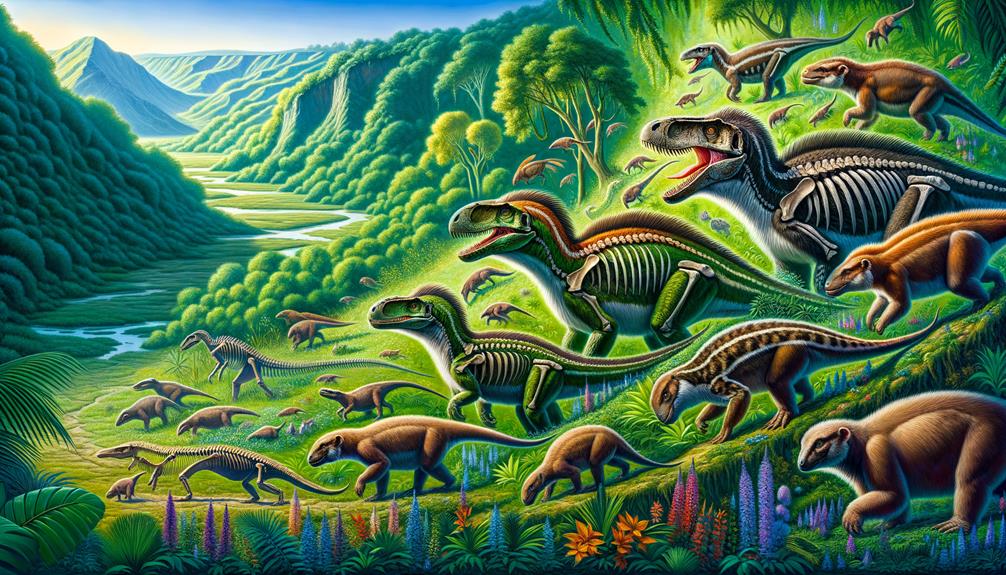
When examining the transition from cynodonts to mammals, I'm drawn to the evolutionary traits that emerged over time. Fossils like Morganucodon offer a glimpse into these transitional forms and their remarkable adaptations. This period also saw a rapid expansion of mammalian life, ultimately giving rise to the diverse range of species we see today.
Evolutionary Traits Development
The shift from cynodonts to mammals was marked by the development of specialized heterodont dentition, allowing for more efficient processing of diverse diets and improved survival. Early species like Morganucodon, one of the earliest known stem mammals, exhibited a mix of reptilian and mammalian characteristics. They had differentiated teeth, including incisors, canines, and molars, a hallmark of modern mammals. This early development paved the way for the evolution of the middle ear, where accessory jawbones gradually moved to form the mammalian middle ear auditory ossicles.
The significance of these changes cannot be overstated. With a secondary palate, cynodonts could chew and breathe simultaneously, a vital adaptation for energy-intensive activities. Additionally, the expansion of the temporal musculature enabled more powerful and precise jaw movements. These characteristics are closely tied to the defining traits of mammals, such as mammary glands and advanced locomotion mechanics.
The articulation of the jaw between the dentary and squamosal bones distinguished these advanced therapsids from their reptilian ancestors, setting the stage for the diverse array of modern mammalian species we see today.
Transitional Fossil Evidence
Examining fossils like Megazostrodon and Morganucodon provides a fascinating glimpse into the gradual evolution from cynodonts to early mammals. These transitional fossils bridge the morphological gap, showcasing the step-by-step nature of this major transformation.
For instance, Megazostrodon exhibits a mix of primitive and advanced features. Its dentary-squamosal jaw joint, a hallmark of true mammals, coexists with retained therapsid traits, such as the quadrate bone still part of the jaw structure. Morganucodon, a 200-million-year-old member of the cynodont group, reveals similar shifting characteristics, reflecting the ongoing shift in jaw muscles and cranial anatomy.
Key markers of this evolution include changes in jaw musculature, which led to the formation of the mammalian middle ear. The development of multiple cranial openings also facilitated the accommodation of larger brain sizes. Additionally, mammal-like features such as differentiated teeth and a secondary palate became more pronounced in these species.
These pivotal fossils are crucial in understanding how therapsids evolved into mammal species over millions of years. By examining these fossils, we can appreciate the gradual yet profound changes that led to the diverse mammal species we see today.
Adaptive Radiation Burst
Adaptive radiation in early mammals, emerging from their cynodont ancestors, sparked a remarkable diversification driven by distinct ecological niches and evolutionary innovations. This evolutionary burst followed the late Carboniferous period, when synapsids first diverged from sauropsids. Advanced cynodonts, evolving specialized heterodont dentition and improved locomotion, laid the groundwork for true mammals. Their adaptive traits, such as the secondary palate and expanded temporal musculature, distinguished them during the Permian.
The devastating Permian-Triassic extinction event wiped out many species, but it also provided ecological opportunities for surviving synapsids. Advanced cynodonts capitalized on these niches, paving the way for mammalian evolution. Fossilized feces from the Permian period reveal their diverse diet and adaptive strategies. By the end of the Triassic, early mammals exhibited key characteristics like a dentary-squamosal jaw articulation and the relocation of accessory jawbones to the middle ear.
This adaptive radiation burst also included a shift to nocturnal living, likely a response to predation pressures and competition with dominant diurnal reptiles. This nocturnality fostered sensory adaptations, essential for the survival and diversification of early mammals. This evolutionary journey showcases nature's remarkable resilience and adaptability.
Early Mammalian Features

Early mammalian features evolved from key innovations in therapsids, including the development of a secondary palate and expanded temporal musculature. These therapsids, found in both North America and South America, laid the groundwork for distinct mammalian characteristics.
Traditionally known as "mammal-like reptiles," therapsids exhibited several distinct features that set them apart from their reptilian ancestors. These included:
- Heterodont dentition, which allowed for varied feeding strategies due to differentiated teeth.
- Erect limb posture, where limbs were positioned beneath the body, enhancing locomotion.
- Jaw articulation changes, where jawbones shifted to middle ear bones, improving hearing capabilities.
These adaptations were crucial in the evolutionary split between reptiles and mammals. The oldest known therapsids, dating back millions of years, showed an increase in body temperature regulation, a precursor to endothermy. The presence of hair for insulation was another hallmark, correlating with the development of warm-bloodedness.
These innovations ultimately led to the emergence of distinct mammalian features that distinguish mammals from their reptilian ancestors.
Mesozoic Mammal Expansion
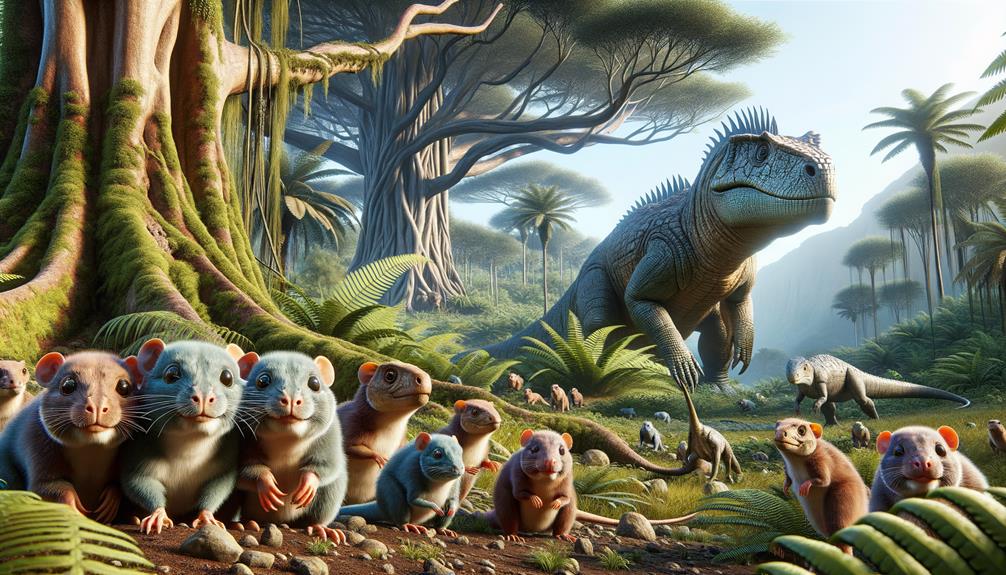
The Mesozoic Era marked a significant turning point in mammalian history, characterized by a remarkable expansion into diverse ecological niches. During this period, mammals were not just passive survivors but active participants in the complex terrestrial vertebrate ecosystems dominated by non-avian dinosaurs.
Fossils and molecular phylogenetics indicate that mammals, including Eutherians and Metatherians, diverged during the Jurassic period, around 160 million years ago. This diversification allowed them to occupy various ecological roles, including:
| Ecological Niches | Examples |
|---|---|
| Aquatic Environments | Semi-aquatic mammals |
| Gliding Habitats | Early gliding mammals |
| Predation | Mammals preying on dinosaurs |
The Cretaceous-Paleogene extinction event, which led to the demise of the non-avian dinosaurs, presented mammals with a unique opportunity. They rapidly diversified and filled the ecological vacancies left behind, ultimately becoming the dominant land animals. Their evolutionary success can be attributed not only to the availability of new niches but also to the versatility of their soft tissues and adaptive behaviors.
Evolution of Major Mammal Groups
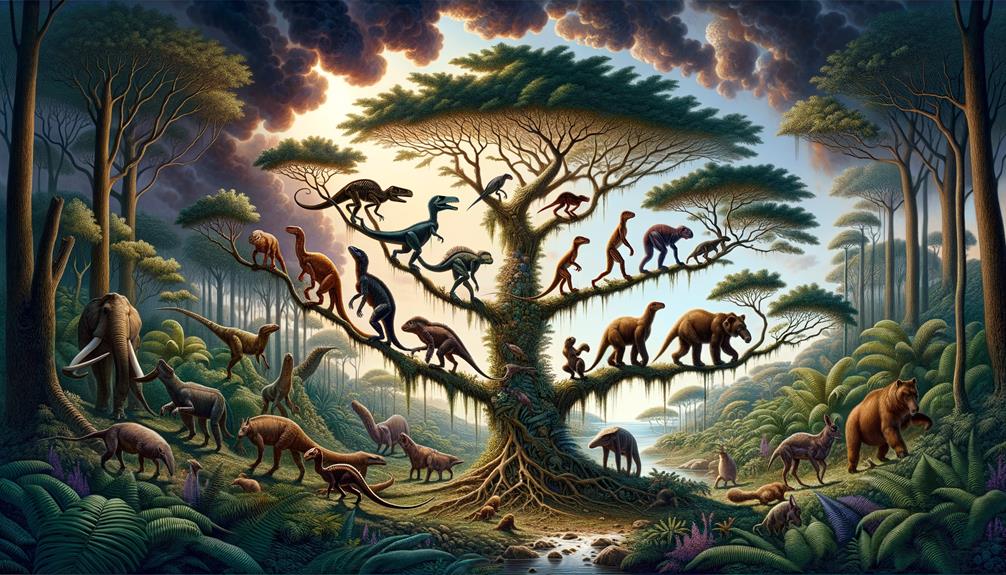
Mammalian evolution, tracing back to synapsid ancestors during the Triassic period around 225 million years ago, has led to the emergence of three major groups: monotremes, marsupials, and placental mammals. Synapsids, characterized by a single temporal fenestra behind each eye, first appeared in the Late Permian and continued through the Early and Middle Permian, featuring the largest land predators of their time.
Monotremes, like the platypus, branched off around 166 million years ago. Marsupials and placental mammals split about 160 million years ago, during the Late Triassic, when dinosaurs dominated the Earth. After the dinosaurs' extinction, placental mammals diversified rapidly, eventually becoming the dominant mammalian group today.
By the end of the Neogene period, around 23 million years ago, all major extant mammalian orders had emerged, resulting in the rich diversity we see in today's mammals. The key points are:
Monotremes are the earliest branch, featuring egg-laying mammals.
Marsupials, pouched mammals, emerged after monotremes.
Placental mammals diversified post-dinosaur extinction and now form the largest group.
This evolutionary journey highlights the remarkable adaptability and resilience of mammals, stemming from their synapsid heritage.
Frequently Asked Questions
How Did Mammals and Reptiles Split?
Mammals and reptiles went their separate ways during the Triassic period. One key group, therapsids, started to develop distinct mammalian features like the ability to regulate their own body temperature, grow hair, and sport specialized teeth. This marked a significant shift away from their reptilian ancestors, showcasing a gradual change in physical characteristics.
Do Mammals Have a Reptilian Ancestor?
Mammals do have reptilian ancestors called therapsids. These ancient creatures evolved during the Triassic period and developed key traits like a diaphragm and mammary glands, laying the groundwork for the diversity of modern mammals.
Which Evolved First Mammals or Reptiles?
Reptiles were the first to evolve, showing up around 320-315 million years ago during the Late Carboniferous period. Mammals came later, emerging around 225 million years ago in the Late Triassic, and they developed from therapsid synapsids that already had some mammalian characteristics.
What Characteristic Separates a Mammal From a Reptile?
Mammals, like a thriving metropolis, have distinct characteristics that set them apart from reptiles. One key difference is their single lower jawbone, unlike reptiles which have multiple jawbones. Another significant distinction is their endothermic bodies, which allow them to regulate their own body temperature, whereas reptiles rely on external sources for heat. Additionally, mammals are known for their complex parental care, which involves nurturing and protecting their young, whereas reptiles often have simpler reproductive strategies.


